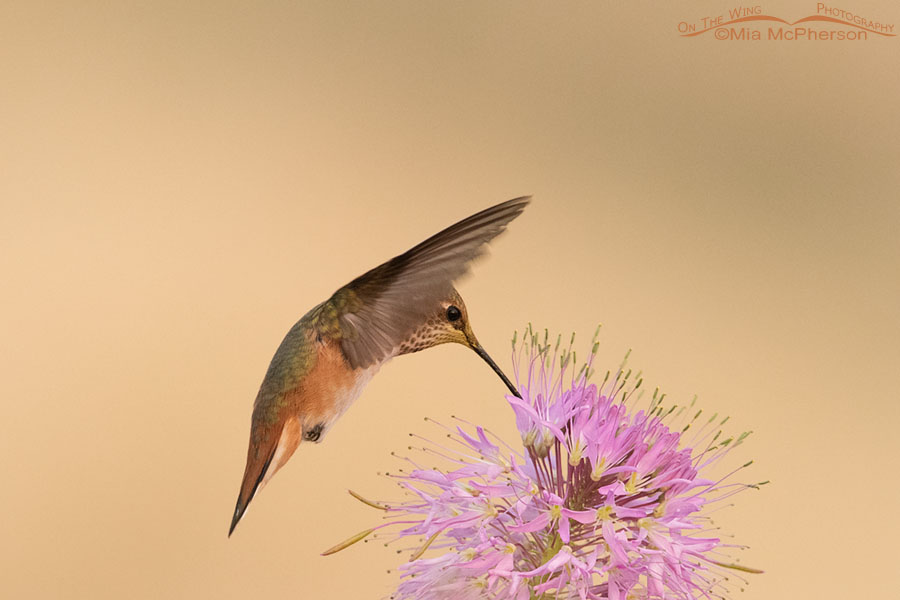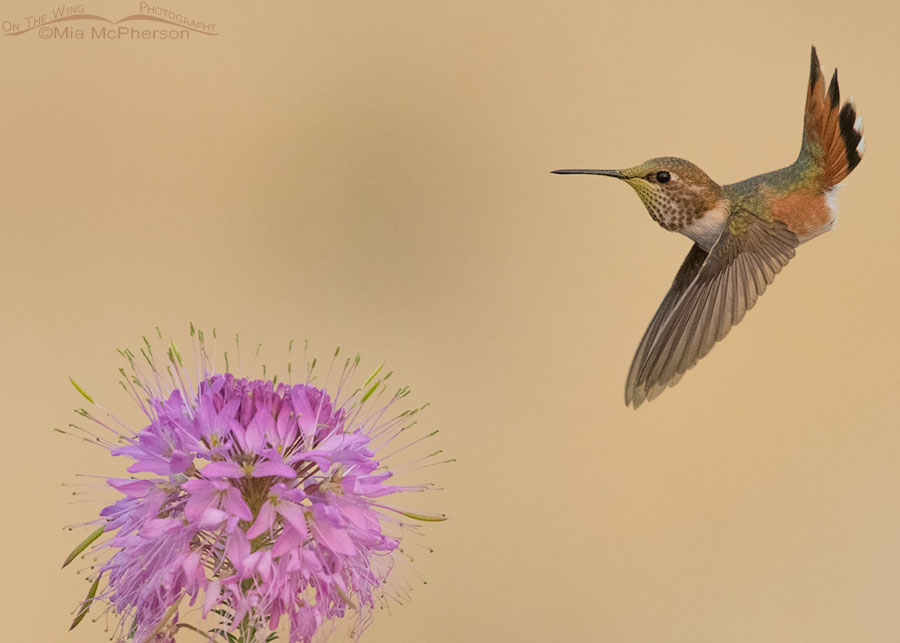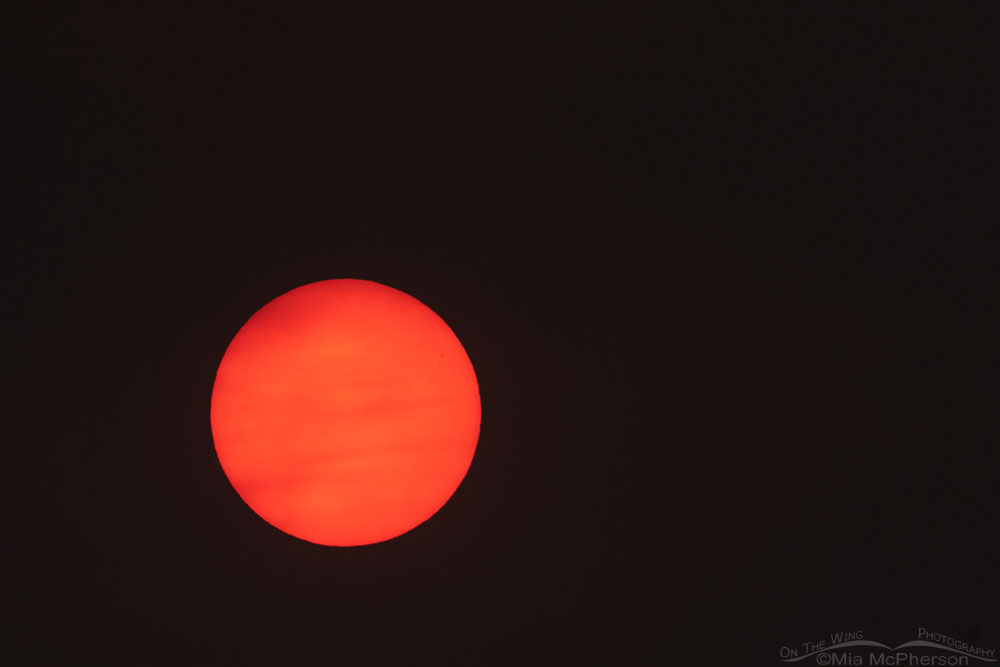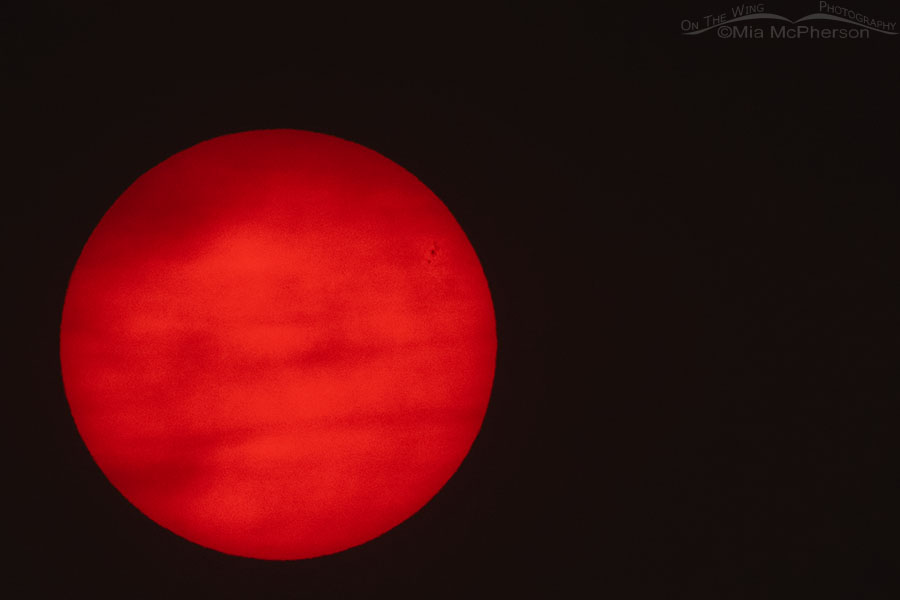 Female/immature Rufous Hummingbird feeding from a Rocky Mountain Bee Plant – Nikon D810, f7.1, 1/1250, ISO 2000, +1.0 EV, Nikkor 500mm VR with 1.4x TC, natural light
Female/immature Rufous Hummingbird feeding from a Rocky Mountain Bee Plant – Nikon D810, f7.1, 1/1250, ISO 2000, +1.0 EV, Nikkor 500mm VR with 1.4x TC, natural light
Yesterday I went out to Antelope Island for the first time since April and I took hundreds of Rufous Hummingbird photos plus some of the rising sun.
The light was awful at first because of the smoke from the wildfires in California, Oregon and Nevada. I used higher ISO settings than I normally like to use to gain enough shutter speed to photograph the fast moving hummingbirds I saw. At times that didn’t even work because my camera seemed to struggle with the amount of smoke in the air and images that should have been sharp weren’t.
I took so many photos of this Rufous Hummingbird that I haven’t had time to go through them all, to pick my favorites, or to look for interesting behaviors in my images.
 Rufous Hummingbird tail flare – Nikon D810, f7.1, 1/3200, ISO 2000, Nikkor 500mm VR with 1.4x TC, natural light
Rufous Hummingbird tail flare – Nikon D810, f7.1, 1/3200, ISO 2000, Nikkor 500mm VR with 1.4x TC, natural light
The hummingbird I photographed most often yesterday I would label as female/immature. Immature male and female Rufous Hummingbirds have tails that look like the females of this species. Male Rufous Hummingbirds have spiky tail feathers that are rufous and tipped with black. The Rufous I photographed yesterday has some tail feathers, or retrices, with white tips. At this time of the year it can be challenging even for experts to tell the difference between adult female and immature Rufous Hummingbirds unless they are in their hands.
From Birds of the World online:
Juvenile/immature (Juvenile plumage; Jun-Nov): resembles female but uppertail coverts mostly rufous, central rectrices mostly rufous to base. Juveniles reliably identified in hand by oblique corrugations or wrinkles on upper mandibles (Ortiz-Crespo 1972); these persist into early winter (WAC).
I selected these two Rufous Hummingbird photos to share today because I like their simplicity, the action shown in them, and that both show the Rocky Mountain Bee Plants in the frame. The bee plant is a native wildflower that is a major attraction for migrating hummingbirds.
Hopefully I will share more of the Rufous Hummingbird photos I took yesterday soon.
 Rising sun through a smoky haze on August 31, 2021 – Nikon D810, f7.1, 1/6400, ISO 640, -1.0 EV, Nikkor 500mm VR with 1.4x TC, natural light
Rising sun through a smoky haze on August 31, 2021 – Nikon D810, f7.1, 1/6400, ISO 640, -1.0 EV, Nikkor 500mm VR with 1.4x TC, natural light
Before I got to where the Rufous Hummingbird was on the island I stopped to take a few poorly lit Burrowing Owl photos. It felt like the last few minutes before the sun sets on a cloudy day. It was gloomy and dark because of the smoke that has filled the Great Basin for weeks due to the wildfires that are west of here.
While I was photographing the Burrowing Owls I glanced towards the east to see where the sun was. It would have been hard to miss the glowing reddish-orange orb in the dark, smoky sky. I decided on the spur of the moment to photograph the sun rising over the Wasatch Mountains to the East. Sunrise was at 6:54 am yesterday, this photo was taken at 7:40. It takes some time for the sun to rise above the mountains and when it first started showing above the mountains the sun was even redder than is shown in this photo.
I adjusted my exposure to compensate for how bright the sun was which made the sky look somewhat darker than it actually was but the sky looked dark because of the smoke. This photo is full frame and simply resized for web presentation.
 Sun and smoky skies on August 31, 2021 – Nikon D810, f7.1, 1/8000, ISO 640, -2.3 EV, Nikkor 500mm VR with 1.4x TC, natural light
Sun and smoky skies on August 31, 2021 – Nikon D810, f7.1, 1/8000, ISO 640, -2.3 EV, Nikkor 500mm VR with 1.4x TC, natural light
Normally I would never aim my camera directly at the sun because that can damage an expensive camera but on a smoky day like yesterday I felt confident that my camera would be fine. I cropped this photo because I wanted to show the sunspots on the upper right quadrant of the sun more clearly than can be seen in the first photo of the sun.
I’ve heard that an incoming weather front is supposed to clear out our air for a bit. I hope so. I also hope that the fires out west of here can be gotten under control. This has been a horrendous wildfire season.
Mia
Click here to see more of my Rufous Hummingbird photos plus facts and information about this species. Click here to see more of my miscellaneous photos of environmental nature, photo art, conservation, man and nature, or images that just do not fit into one specific category.


Love the action you caught with the hummingbird in flight. The composition of both pics is terrific. The sun shots are otherworldly. Scary thought – is this a harbinger of our future? Thanks Mia.
Love your hummingbird photos….and that spectacular sunset photo! Wow!
Beautiful photos! I love the sun spots too. I need to get out there before the flowers and birds are gone!
Stunning shots that made a sweet treat from wrinkled lemon conditions
The Rufous Hummingbird shots are outstanding. The photo of the sun of great too until you realize it is red like that from the smoke.